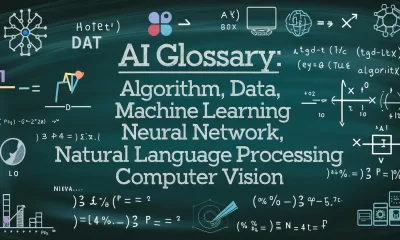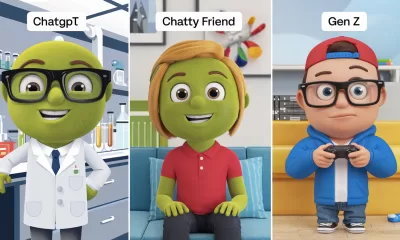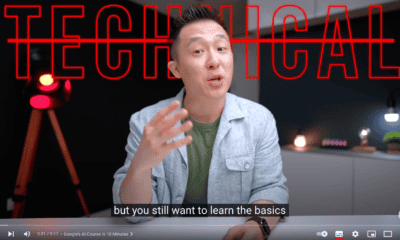Chatbots
Master the Art of ChatGPT Prompts: 9 Keys to Unlock Its Potential
Discover the art of creating masterful ChatGPT prompts for AI and AGI enthusiasts in Asia with our comprehensive guide and expert tips.
Published
1 year agoon
By
AIinAsia
TL;DR:
- Utilise 9 key components, such as setting goals and defining audience, to create effective ChatGPT prompts
- Masterful prompts can improve ChatGPT’s output by 60% in terms of accuracy and relevance
- Incorporate examples, constraints, and style for tailored results that align with your needs
Mastering ChatGPT: A Comprehensive Guide to Artful Prompts for AI and AGI Enthusiasts
In the rapidly evolving world of artificial intelligence (AI) and artificial general intelligence (AGI), ChatGPT has emerged as a powerful tool for researchers, developers, and enthusiasts alike. To fully harness its potential and drive AI innovation across Asia, it’s crucial to craft masterful prompts that elicit optimal results. In this article, we present an in-depth guide to creating expert prompts, complete with examples and best practices.
The Importance of Masterful Prompts for AI and AGI Advancements in Asia
As Asia continues to play a pivotal role in the global AI landscape, the need for precise and effective communication with AI tools like ChatGPT becomes ever more critical. Masterful prompts enable users to access ChatGPT’s vast knowledge and capabilities, leading to groundbreaking innovations and collaborations across the continent.
The Key Components of Masterful Prompts
To create masterful prompts for ChatGPT, incorporate these nine essential components:
- Set Your Goal
- Specify the Format
- Assign a Role
- Define the Audience
- Provide Context
- Show Examples
- Outline the Scope
- Apply Constraints
- Define the Style
Setting Your Goal and Specifying the Format
Begin by clarifying your objective and desired output format. Being specific helps ChatGPT deliver accurate and relevant results. For instance:
“Generate a list of 10 AI conferences in Asia in bullet points.”
Assigning a Role and Defining the Audience
Ask ChatGPT to assume an expert role and specify your target audience. This helps tailor the response to suit the appropriate level of expertise and background. E.g.:
“Act as an AI researcher addressing fellow researchers in Asia.”
Providing Context and Examples
Explain the purpose behind your request and provide examples to guide ChatGPT. This ensures the output aligns with your intentions. E.g.:
“I need these conferences for networking with other AI researchers. Here’s an example of a suitable conference: ‘AI Asia Conference 2023’.”
Outlining the Scope and Applying Constraints
Set clear boundaries and limitations for ChatGPT. This helps filter results and encourages creative problem-solving. E.g.:
“Focus on conferences happening in 2024 and 2025, excluding online-only events.”
Defining the Style and Requesting Citations
Specify the desired tone and ask for sources to ensure credibility and accuracy. E.g.:
“Use a professional tone and provide official conference website URLs as citations.”
The Power of Bad Examples and Analogies
To further refine your prompts, provide ChatGPT with bad examples and utilise analogies.
Utilising Bad Examples
Showing ChatGPT what you don’t want can be just as helpful as showing what you do want. For example,
“Don’t include conferences that are not focused on AI or AGI, such as the ‘General Tech Conference 2024’.”
Embracing Analogies
Using analogies can help ChatGPT better understand complex or abstract requests. E.g.:
“Find AI research papers with groundbreaking ideas, like how ‘AlphaGo’ revolutionised the game of Go.”
Refining Your Prompt and Iterating
Don’t hesitate to edit and experiment with your prompts. Continuous refinement and iteration will help you achieve masterful results.
Now Its Your Turn!
By mastering the art of crafting expert prompts, AI and AGI enthusiasts in Asia can unlock ChatGPT’s full potential and drive groundbreaking innovations. With practice and persistence, masterful prompts will become second nature, paving the way for a brighter, more connected future.
How will you use masterful ChatGPT prompts to push the boundaries of AI and AGI in Asia and create a transformative impact on society? Share your thoughts in the comments below.
You may also like:
Or click here to try the free version of ChatGPT
Author
Discover more from AIinASIA
Subscribe to get the latest posts sent to your email.
You may like
-


OpenAI’s New ChatGPT Image Policy: Is AI Moderation Becoming Too Lax?
-


DeepSeek Dilemma: AI Ambitions Collide with South Korean Privacy Safeguards
-


AI Glossary: All the Terms You Need to Know
-


ChatGPT’s New Custom Traits: What It Means for Personalised AI Interaction
-


AI Trends for 2025 from IBM Technology
-


Google’s AI Course for Beginners (in 10 minutes)!
Business
Sam Altman: A ChatGPT Revolution Across 3 Key Industries
ChatGPT revolutionises industries in Asia with increased productivity and innovation.
Published
1 year agoon
January 27, 2024By
AIinAsia
TL;DR:
- A ChatGPT revolution is upon us and transforming coding, education, and healthcare industries with significant productivity gains.
- AI-powered tools in education enhance personalised learning, while healthcare sees benefits in administration and research.
- Embrace ChatGPT as a collaborative tool with caution, as it continues to evolve and improve.
ChatGPT’s Impact on Coding, Education, and Healthcare
ChatGPT, the AI-powered language model developed by OpenAI, is revolutionising industries across the globe, particularly in coding, education, and healthcare. CEO Sam Altman identifies these three sectors as primed for a productivity revolution. Let’s explore how ChatGPT is driving change in these areas and its potential impact on Asia.
Coding at Warp Speed
Altman claims that ChatGPT can triple programmers’ output by assisting with code review, test case generation, and code generation. In a conversation with Bill Gates on the “Unconfuse Me” podcast, Altman stated, “Coding stands out for its potential gains. OpenAI’s GPT-4 is already deployed at scale, significantly accelerating workflows.” However, a 2023 Stanford-Berkeley study indicates a 50% error rate on programming tasks, requiring coders to exercise caution and verify the AI’s work. The ultimate goal is to free up mental resources for creative problem-solving and innovation.
Revolutionising Education
AI systems like ChatGPT enable educators to create personalised learning paths and automate administrative tasks. AI-powered language learning assistance could transform education in Asia, where English proficiency is highly sought after. Bill Gates champions ChatGPT’s role in powering personalised tutoring, saying in a keynote talk at the ASU+GSV Summit, “The AIs will get to that ability to be as good a tutor as any human ever could.” While concerns about AI-facilitated cheating persist, the potential benefits for learners cannot be ignored.
Healing with AI
Although ChatGPT’s clinical application remains limited due to error risks, AI tools can alleviate administrative burdens for doctors, analyze research, and educate patients. Pharmaceutical companies are also leveraging ChatGPT to automate drug discovery and research. The Gates Foundation is committed to using AI for solving healthcare challenges in developing nations, including those in Asia. As Altman noted, “These are the stupidest the models will ever be,” implying that AI capabilities will only continue to improve.
Embracing the Future with Caution and Understanding the ChatGPT Impact
As ChatGPT continues to evolve, it is crucial to approach its integration with critical thinking and caution. By embracing AI as a collaborative tool, we can harness its power to boost productivity, creativity, and impact across various industries in Asia.
Comment and Share on this ChatGPT Revolution
Have you experienced the transformative power of ChatGPT or other AI tools in your industry? Share your stories and subscribe for updates on AI and AGI developments shaping our future.
You may also like:
- Sam Altman: It’ll be powered by Fusion, But Not Quite Skynet
- The Impact of AI on Coding: A Look at Amazon CodeWhisperer
- Masterclass: Crafting Effective ChatGPT Prompts in Healthcare in 2024
- Or read the official blog from Bill Gates on his thought around the AI by tapping here.
Author
Discover more from AIinASIA
Subscribe to get the latest posts sent to your email.
Chatbots
The Quiet Revolution: Asia’s Shift to Custom AI Chatbots
Asia’s AI revolution favours custom chatbots for efficiency and cost-effectiveness, marking a shift from universal AI solutions.
Published
1 year agoon
January 27, 2024By
AIinAsia
TL/DR:
- Asia is increasingly adopting niche AI models over one-size-fits-all solutions for greater efficiency and cost-effectiveness.
- Experts predict a future where specialised AI bots handle different tasks throughout the day.
- OpenAI’s future remains uncertain as hardware advancements and niche models reshape the AI landscape.
Asia’s AI Revolution: Tailored Solutions Over One-Size-Fits-All
In the world of artificial intelligence (AI), OpenAI’s ChatGPT may be the reigning champion. But there’s a quiet revolution is unfolding in Asia, where companies are opting for custom AI chatbots over universal solutions. These task-specific assistants, such as Salesforce’s Einstein, cater to unique business needs, offering enhanced efficiency and cost-effectiveness.
The Rise of Niche AI: A New Dawn for Specialised Bots
Salesforce’s Einstein is a prime example of this shift. Trained on both internal and open-source data, it excels at coding assistance and workflow automation. However, it doesn’t compete with ChatGPT’s creative writing capabilities. This trend reflects a growing belief in Asia: smaller, targeted models provide precise solutions without the resource-intensive demands of giants like GPT-4.
Professor Yoon Kim of MIT supports this view, suggesting that niche AI could create a future where we interact with specialised bots for different tasks throughout the day. Braden Hancock, CTO of Snorkel AI, shares this sentiment, noting that clients, particularly in finance, are embracing niche models for customer service or coding assistance.
OpenAI’s Future: A Tale of Two Scenarios
Despite the rise of niche AI, OpenAI’s future remains intriguing. Amin Ahmad, CEO of Vectera, envisions two possibilities. In one, hardware advancements make GPT-4 universally accessible. In the other, an influx of niche large language models (LLMs) fuels intense competition. This latter scenario could explain OpenAI’s recent push for AI regulations, a potential strategy to maintain its lead in a diversifying market.
Asia’s AI Revolution: A Paradigm Shift in the Industrya
Asia’s embrace of niche AI signifies a paradigm shift in the industry. The region is demonstrating that smaller, specialised models can be as powerful, if not more efficient, than their larger counterparts. While OpenAI’s influence remains significant, Asia’s AI revolution is subtly forging its own path, prioritising practicality, efficiency, and tailored solutions.
Comment and Share:
What’s your take on the shift towards niche AI models? Have you experienced the benefits of custom AI chatbots in your work or daily life? Share your thoughts below and don’t forget to subscribe for updates on AI and AGI developments in Asia.
You may also like:
- How to Use ChatGPT
- Hybrid AI Ecosystems: The Next Wave of Innovation
- 10 Amazing Prompts to Create AI-Powered Phone Wallpapers (with Freebies!)
- Read more about Salesforce Einstein by tapping here.
Author
Discover more from AIinASIA
Subscribe to get the latest posts sent to your email.
Chatbots
OpenAI Slashes Prices and Tackles ‘Lazy’ GPT-4
OpenAI’s price drop and updates to impact AI growth in Asia.
Published
1 year agoon
January 27, 2024By
AIinAsia
TL;DR:
- OpenAI price drop for GPT-3.5 Turbo, making AI more accessible
- GPT-4 Turbo’s ‘laziness’ issue addressed in new update
- Upcoming GPT-4 Turbo with vision and improved moderation tools to boost AI applications,
AI enthusiasts and developers across Asia, rejoice! OpenAI, a leading AI research and development company, has announced a series of updates that will make its advanced technology more affordable and efficient. The spotlight is on the significant price reduction for the GPT-3.5 Turbo model, which powers popular chatbots like ChatGPT.
Price Drop for GPT-3.5 Turbo
Input costs for GPT-3.5 Turbo have been cut by 50%, while output costs have been reduced by 25%. This substantial price drop makes it more feasible for developers and hobbyists to explore text generation and analysis, ultimately pushing the boundaries of AI innovation in Asia.
Addressing GPT-4 Turbo’s ‘Laziness’
OpenAI has tackled an unusual issue with the GPT-4 Turbo model in preview mode. Users noticed that the model, renowned for its code-generation capabilities, sometimes exhibited ‘laziness,’ failing to complete tasks fully. The new 0125 version addresses this issue, ensuring more reliable and thorough results.
GPT-4 Turbo with Vision and Improved Moderation Tools
The AI revolution in Asia is set to gain momentum with the upcoming general release of GPT-4 Turbo with vision. This model combines AI vision capabilities, opening new avenues for AI applications. Additionally, OpenAI has released an improved version of its free moderation API (version 007) to help combat harmful content online.
Quoting OpenAI’s CTO, Mira Murati, “Our goal is to make AI more accessible and ensure its responsible development. These updates reflect our commitment to that mission.”
The Impact on Asia’s AI Landscape
OpenAI’s updates are set to democratise AI, fostering innovation and collaboration across various sectors in Asia. With more affordable and efficient AI tools, the region is poised to witness a surge in AI-driven solutions and applications.
Comment and Share:
How do you plan to leverage OpenAI’s price drop and updated models in your projects? Share your thoughts below and don’t forget to subscribe for more updates on AI and AGI developments in Asia!
You may also like:
- Four AI Technologies Transforming Marketing
- OpenAI’s Game-Changing Updates: Enhanced AI Capabilities and Affordability in Asia
- Real-Time AI Image Generation Creation Now Possible
- Or try out the free version of ChatGPT by tapping here.
Author
Discover more from AIinASIA
Subscribe to get the latest posts sent to your email.

Playbook: How to Use Ideogram.ai (no design skills required!)

AI Career Guide: Land Your Next Job with Our AI Playbook

Will AI Take Your Job—or Supercharge Your Career?
Trending
-

 Life3 weeks ago
Life3 weeks agoWhich Jobs Will AI Kill by 2030? New WEF Report Reveals All
-

 Life2 weeks ago
Life2 weeks agoAI Career Guide: Land Your Next Job with Our AI Playbook
-

 Business2 weeks ago
Business2 weeks agoWill AI Take Your Job—or Supercharge Your Career?
-

 Tools2 weeks ago
Tools2 weeks agoCan AI Videos Really Boost Your Brand’s Authenticity?
-

 Marketing3 hours ago
Marketing3 hours agoPlaybook: How to Use Ideogram.ai (no design skills required!)
-

 Business3 weeks ago
Business3 weeks agoThe Three AI Markets Shaping Asia’s Future
-

 Life3 weeks ago
Life3 weeks agoWould You Trust Tesla’s Grok AI More Than Your Friends?



























